Basic information about the full court press
The full court press is a defensive system that typically focuses on carrying out specific strategies which implement backcourt and/or frontcourt defensive pressure against the offensive team.
Moreover, defenders can use the full court press to trap an offensive player in possession of the basketball, particularly near sidelines or corners of the court.
Generally speaking, the main goal of the full court press is to disrupt offensive flow and potentially create turnovers, which could possibly result in easier or at the very least, extra scoring opportunities, once the former defensive team gains possession of the ball.
Examples of full court press defenses
This section contains examples of full court press defenses, most notably the 1-1-2-1 press defense and the 1-1-3 press defense at this current time.
However, more information in relation to other types of press defenses are planned for a later date.
Additionally, in reference to any diagrams in subsequent sections below, each defensive player is indicated by the letter X shown alongside a number.
For the purposes of this web page, this letter X and the adjacent number symbolizes one of the standard basketball positions.
This also applies to any diagrams featuring offensive players. However, those same offensive players will simply be referred to as their respective number without the letter X.
In essence, the defensive and offensive point guards are denoted as X1 and 1, respectively. The defensive and offensive shooting guards are indicated as X2 and 2, respectively.
The defensive and offensive small forwards are represented as X3 and 3, respectively. The defensive and offensive power forwards are signified as X4 and 4, respectively.
Lastly, the defensive and offensive centers are denoted as X5 and 5, respectively.
1-1-2-1 press defense
The 1-1-2-1 press defense is a basketball strategy that emphasizes defensive pressure as well as traps near the corners, ultimately to create turnovers or at minimum, to disrupt offensive scoring opportunities near the basket or near perimeter areas of the court.
Furthermore, this particular press defense, as well as several other full court defenses, use a numbering system in which each digit represents the general alignment for the defensive players on the court.
To give more clarity of this concept, the digits between dashes represent the number of defensive players that will be located in a certain region of the court, typically based on the front, the middle, or the back.
Also, more dashes in a numbering format generally means more regions for the players to occupy on the court.
Basically, one dash would generally represent two regions of the court that players would fill.
An example of that would be the 2-3 zone defense, which contains two players in the front region and three players in the back region.
Furthermore, two dashes would typically signify three regions for players to occupy on the court.
An example of that would be 1-2-2 press defense, which contains one player in the front region, two players in the middle region, and two additional players in the back region.
In a similar fashion, three dashes would usually be indicative of four regions that players would fill on the court.
An example of that would be this 1-1-2-1 press defense in which the players will align in four regions on the court from the front to the back.
At any rate, the diagrams below showcases various examples of the 1-1-2-1 press defense.
Example of initial setup for the 1-1-2-1 press
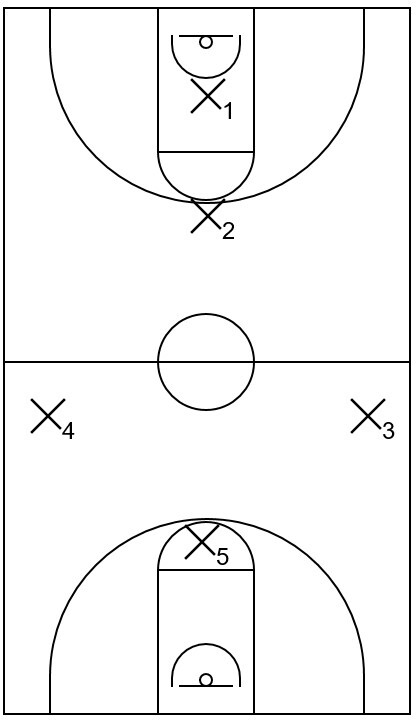
This is an example of the initial setup for the 1-1-2-1 press defense. In essence, X1 starts in the offensive team’s backcourt within the lane between the basket and the free throw line.
X2 also begins in the offensive team’s backcourt as well, but at the top of the three-point arc.
X3 and X4 start in the offensive team’s frontcourt near the half court line and sidelines.
In addition, X5 begins in the frontcourt but near the high post, also known as the nail area in this instance.
Example of initial backcourt defensive pressure within the 1-1-2-1 press
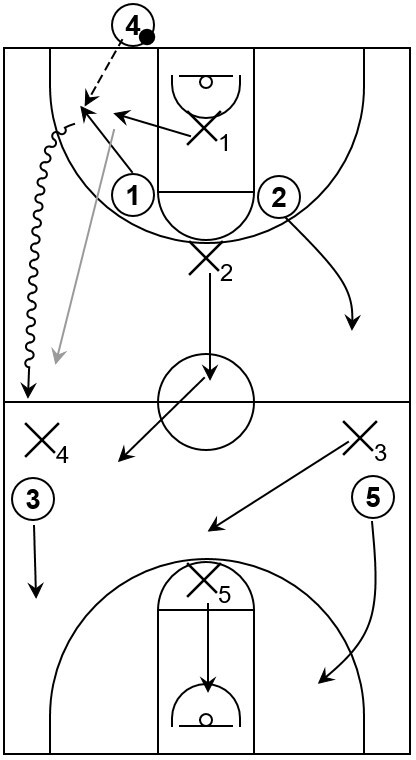
This is an example of initial defensive pressure in the backcourt for the 1-1-2-1 press defense.
To begin, 1 receives the ball via an inbound pass from 4.
As that happens, X1 immediately applies defensive pressure and executes a proper defensive slide to influence 1 towards the adjacent sideline.
From there, 1 begins dribbling down the court near the sideline, represented by the arrow with a wavy line while X1 mirrors that path, indicated by the gray arrow towards the half court line.
In addition, as those actions transpire, X2 initially drops back to protect the middle area in the backcourt while X3 protects the middle in the frontcourt.
What’s more, as 5 cuts below the free throw line extended, X5 drops back to protect the basket.
Also, as 1 begins to dribble or pass into the frontcourt area, X2 slides toward the extended slot area in the frontcourt, mainly to be a hindrance if 1 attempts to pass the ball to the adjacent frontcourt wing area.
Example of first potential trap within the 1-1-2-1 press
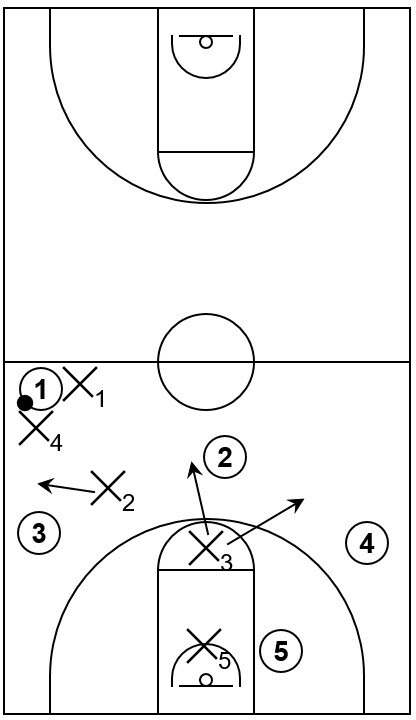
This is an example of the first potential trap that could occur while implementing the 1-1-2-1 press defense.
If X1 successfully influences 1 into dribbling down the nearest sideline, then X4 could set a trap in the corner with X1 once 1 crosses the half court line.
Moreover, X2 could continue to hinder a possible passing option for 1 by playing denial defense against 3 near the wing area.
In other words, X2 could place a hand in the passing lane between 1 and 3, represented by the arrow, ultimately to increase the difficulty of 3 receiving an easy pass from 1.
In addition to that, X3, who is currently near the high post, could potentially intercept passes thrown to either 2 or 4 near the top or opposite wing respectively.
X5 continues to protect the basket, similar to the previous diagram.
It should be noted as well that for these examples, a defensive three-second rule is not in play, which allows X5 or other defenders to stay in the lane on an indefinite basis.
1-1-3 press defense
The 1-1-3 press defense is a basketball defensive strategy that uses on-ball pressure and sideline traps to disrupt offensive flow, which in turn, limits scoring opportunities and generates turnovers.
The diagrams below showcases various examples of the 1-1-3 press defense.
Example of initial setup for the 1-1-3 press
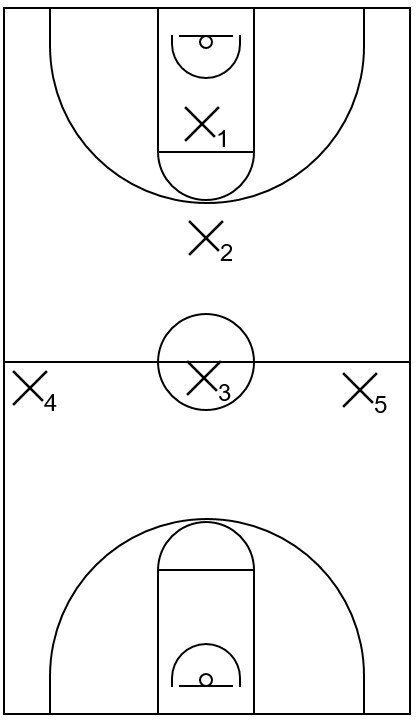
This is an example of the initial setup for the 1-1-3 press defense. X1 begins in the offensive team’s backcourt slightly below the free throw line inside of the lane or key area.
Additionally, X2 occupies space in the offensive team’s backcourt at the top above the three-point arc.
In terms of the offensive team’s frontcourt, X3 begins near the center of the court while X4 and X5 cover the corner areas near the half court line.
Example of initial backcourt defensive pressure within the 1-1-3 press
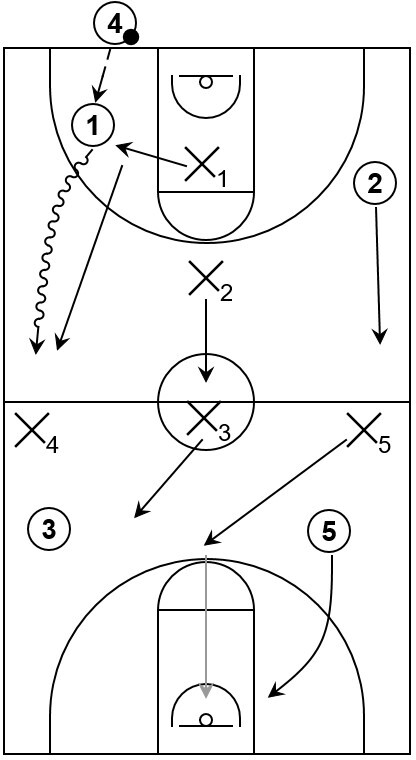
This is an example of initial defensive pressure within the 1-1-3 press that could occur when an offensive player receives the ball in their backcourt.
Basically, 1 receives the ball from 4 and then X1 influences 1 to dribble towards the sideline.
As that occurs, X4 is in preparation to set the first potential trap while X2 covers the middle to possibly hinder or prevent any passes within that area.
Additionally, X3 slides to the ball side wing area while X5 slides towards the top in the middle above the three-point line.
Moreover, if an offensive player such as 5 begins to cut below the free throw line extended area towards the basket, then X5 can also drop back to protect the basket, as indicated by the gray arrow on the diagram.
Example of first potential trap within the 1-1-3 press
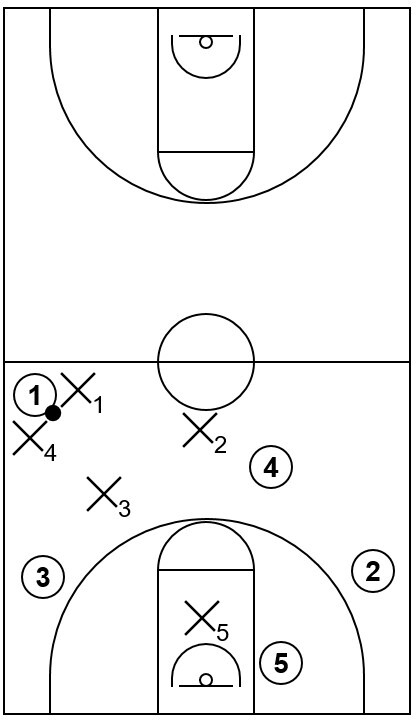
This is an example of the first potential trap that could possibly happen when running the 1-1-3 press defense.
Essentially, X1 and X4 set the trap near the sideline after the ball moves across the half court line into the offensive team’s frontcourt.
In addition to that, X2 protects the middle area after sliding down from the offensive team’s backcourt.
Moreover, X3 continues to cover the ball side wing area looking to intercept any potential passes near that area. Finally, X5 continues to protect the basket.
Additional full court press concepts to consider
Potential advantage of full court press
One potential advantage of the full court press in general is simply its ability to disrupt the rhythm and flow of the offense.
Generally speaking, offensive teams would typically prefer to play at their own fast or slow pace, regardless if the basketball offense that they are executing is a type of half court set, motion, continuity, or transition offense.
However, if the defensive team implements a full court press, then this essentially forces the offensive team to play at a pace (usually a faster one) which might not be suitable for the offensive team’s strategies or personnel.
As a result of the full court press, the offensive team could potentially take undesirable field goal attempts such as contested jump shots or make errors such as bad passes, which could then lead to turnovers.
Notable disadvantage of full court press
One notable disadvantage of the full court press, particularly in reference to certain defensive strategies, is potential gaps or holes that could be exploited by the offensive team.
In essence, when implementing certain full court press strategies, defenders will generally cover certain areas of the court.
What’s more, as the ball moves from one location on the court to another, defenders will also commonly shift from one area to another.
However, when that happens, the press could be susceptible to gap exposure, which the offensive team could possibly take advantage of by passing in between those gaps, ultimately in an attempt to break the press.
This is usually even more of a factor when the middle gap of the press gets exposed, even when that exposure only happens momentarily.
From there, if an offensive team, particularly one with a high basketball IQ, successfully passes the ball into the middle gap, that will effectively break the press because the defensive team will no longer be able to implement the appropriate amount of pressure nor will they be able to set traps near sidelines.
Furthermore, at that point, the defensive team will usually be vulnerable to offensive scoring opportunities such as transition layups or open three-point jump shots.
When to generally consider running a full court press
Defensive team is undersized
A defensive team could consider full court pressure when they are undersized, particularly at the low post positions.
Basically, when the defensive team implements full court pressure, this effectively forces the offensive team to play through their guards or wing players.
Moreover, if the offensive team desires to break the press efficiently, especially in the backcourt, then they would potentially have to move either one or both of their low post players initially away from the basket and towards the backcourt.
From that point, those same low post players would help alleviate the pressure and act as additional passing options for the offensive team.
However, because those low post players are not near the basket, at least during the initial phases of the press, they would not be able to immediately use their low post skills, as they normally would against a standard half court defense.
Defensive team possesses average or less than average scorers when executing offense
The defensive team could consider executing a full court press when the players possess average or less than average offensive scoring ability but at the same time, they are above average defenders.
When that occurs, the full court press could help the defensive team to create turnovers that could result in more offensive possessions and subsequent field goal attempts.
Furthermore, if the defensive team is able to create live-ball turnovers, then that could also be beneficial as those types of turnovers could lead to easy layups or dunks near the rim.
Defensive team is losing the game
If the defensive team is losing the game, then they can set up a full court press to ultimately change the pace of the offense.
That, in turn, could influence the opposition into taking low quality shots or cause them to play too fast and loose, which could result in turnovers as well as scoring opportunities afterwards for the pressing team.
Essentially, if the defense is able to influence the offense into taking bad shots or executing bad passes which lead to turnovers, especially live-ball turnovers, then the defense, who would transition into offense, can use those new possessions to generate scoring opportunities of their own.
Moreover, those new scoring opportunities, which could be near the basket, via layups/dunks, or near the perimeter such as three-pointers, could help the defensive team reduce the scoring deficient or even take the lead during a game.
Offensive team comprises players with less than average dribbling skills or IQ
When the offensive team has one or more players with below average dribbling skills or less than ideal basketball IQ, the full court press could be implemented to take advantage of that ineptness.
These particular players generally do not function well against pressure defense, particularly in the backcourt.
Therefore, if the defensive team implements on-ball pressure and/or sideline traps against those types of offensive players, then those same players could possibly fold under the defensive pressure and turn the ball over.
Furthermore, even if the offensive players do not necessarily turn the ball over, they will generally not be able to effectively and efficiently run their desired motion, continuity, or other types of sets, primarily due to the pressure.
Offensive team is not prepared for or expect the full court press
Another opportunity to consider executing the full court press is simply when the offensive team is not prepared for it or when the offensive team does not necessarily expect it to see it.
This may occur when the offensive team just scored a basket, or after a timeout, or even towards the end of a period.
As an example, if the defensive team normally plays standard half court man to man defense primarily during a quarter or even the whole game, then the offensive team would most likely become accustomed to that type of defense.
From that point, the offensive team will also attempt to run various actions that are designed to limit the effectiveness of the half court man to man defense.
However, if the defensive team implements a full court press at some point during the game, then the offensive team may be unprepared to deal with that type of defensive strategy.
This can be especially detrimental when the offensive team did not scout the press prior to the game or even see it executed by the defensive team at some previous point during the current game.
If that were to happen, then the offensive team might become confused and be forced to call a timeout to set up a press break offense which could counter against the full court press defense.
Also, if the offensive team does call a timeout to counter the full court press, then the defensive team could switch to another type of defense instead of the full court press that the offensive team just observed.
If that occurs, it would mean that the offensive team burnt a timeout to prepare press breaking actions that would not be very useful to them at that time.
On the other hand, the offensive team might simply panic and swiftly turn the ball over upon witnessing the full court press defense.